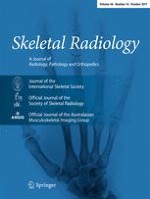Erschienen in:

20.06.2017 | Scientific Article
Role of MRI in predicting meniscal tear reparability
verfasst von:
Paolo Florent Felisaz, Francesco Alessandrino, Simone Perelli, Giacomo Zanon, Francesco Benazzo, Fabrizio Calliada, Luigi Sammarchi
Erschienen in:
Skeletal Radiology
|
Ausgabe 10/2017
Einloggen, um Zugang zu erhalten
Abstract
Objective
To elucidate the role of MRI in predicting meniscal tear reparability according to tear type and location in relation to vascular zones.
Materials and methods
In this retrospective study, two readers evaluated 79 pre-surgical MRIs of meniscal tears arthroscopically treated with meniscectomy or meniscal repair. Tears were classified according to type into vertical, horizontal, radial, complex, flaps and bucket handle and were considered reparable if the distance measured from the tear to the menisco-capsular junction was less than or equal to 5 mm. Predictions were compared with the surgical procedure performed in arthroscopy. We assessed the diagnostic performance of MRI, agreement between MRI and arthroscopy, and interrater agreement. Then, we conducted an ROC analysis on the distances measured by the first reader and built a multivariate logistic regression model.
Results
MRI had a sensitivity, specificity, PPV, NPV and accuracy, respectively, of 85%, 79%, 86%, 76% and 83% in predicting meniscal tear reparability. Correct predictions for the specific tear pattern were 76% for vertical, 84% for horizontal, 88% for radial, 86% for complex, 84% for flaps and 86% for bucket handle. Agreement between the two readers’ predictions and arthroscopy was good (k = 0.65 and 0.61, respectively). Inter-rater agreement was almost excellent (k = 0.79). The ROC analysis revealed sensitivity and specificity of 73% and 83% with a cutoff value of <4 mm (p < 0.001). Anterior cruciate ligament injury and medial meniscal tear increased the likelihood of meniscal tear reparability.
Conclusions
MRI can be a reliable and accurate tool to predict the reparability of meniscal tears, with higher prediction rates for bucket-handle tears.